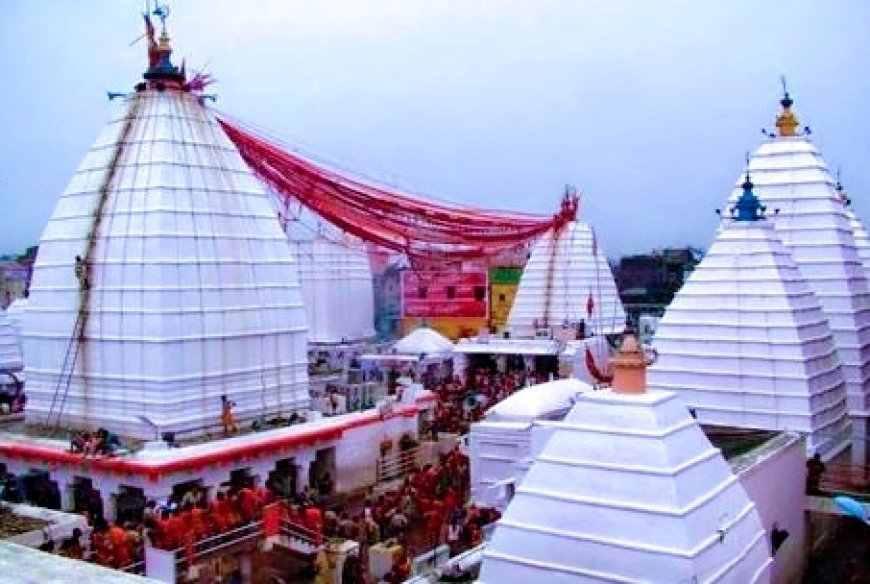Baba Baidyanath Dham, Jharkhand

Baba Baidyanath Dham
Baba Baidyanath Temple, also known as Baidyanath Dham or Baidyanath Jyotirlinga Temple, is one of the most prominent Hindu temples located in Deoghar, Jharkhand, India. It is dedicated to Lord Shiva and is considered one of the twelve Jyotirlingas, which are believed to be the most sacred abodes of Lord Shiva.
Address: Baba Baidyanath Temple,
Baidyanath Dham,
Deoghar, Jharkhand - 814112, India.
The temple is believed to have been built in the 9th century AD, although its exact origins are unclear. It is mentioned in various Hindu scriptures and is considered an important pilgrimage site for devotees of Lord Shiva. The temple complex is spread over a large area and comprises several smaller shrines dedicated to different deities.
The main deity of the temple is Lord Shiva in the form of a Jyotirlinga, which is a representation of the divine and infinite nature of Lord Shiva and 21 other temples. The lingam is believed to be a self-manifested lingam, known as the Baba Baidyanath Jyotirlinga, and is highly revered by devotees.
The temple attracts a large number of devotees, especially during the holy month of Shravan (July-August) when devotees undertake a rigorous 108-kilometer-long pilgrimage known as the "Kanwar Yatra" to fetch holy water from the Ganges River in Sultanganj, Bihar. They carry the water in pots suspended from a bamboo pole and offer it to the Baba Baidyanath Jyotirlinga.
The architecture of the temple is a blend of the traditional and modern styles, with intricate carvings and designs adorning its walls and pillars. The temple complex also includes various other structures such as the Kamna Lingam, Parvati Temple, Nandi Mandap, and several other smaller shrines.
Overall, Baba Baidyanath Temple is not only an important religious site but also a significant cultural and architectural landmark in Jharkhand, attracting devotees and tourists from all over India and beyond.
How to Reach Deoghar:
Deoghar, where Baba Baidyanath Temple is located,
- By Air: The nearest airport to Deoghar is Deoghar International airport and the Birsa Munda Airport in Ranchi, which is approximately 250 kilometers away. From the airport, you can hire a taxi or take a bus to reach Deoghar.
-
By Train: Deoghar has its own railway station called Jasidih railway station has 7 Km distance from Baidyanath dham, which is well-connected to major cities in India. Regular trains operate to and from Deoghar, making it convenient for devotees and visitors to reach the town by rail.
-
By Road: Deoghar has good road connectivity, and it can be reached by bus or private vehicle. National Highway 114 passes through Deoghar, connecting it to nearby cities and towns. State-run buses and private buses operate regular services to Deoghar from cities like Ranchi, Patna, Kolkata, and other nearby towns.
-
Local Transportation: Once you reach Deoghar, you can easily get around the town using local transportation options. Auto-rickshaws, and taxis are available for local commuting. Many devotees also prefer to walk to the temple complex as it is located within the town and easily accessible on foot.
Legend of Baidyanath dham:
According to legend, the origin of Baba Baidyanath Temple is associated with the mythological tale of Ravana, the demon king of Lanka, and Lord Shiva. The legend goes as follows:
Once, Ravana, a devout follower of Lord Shiva, performed intense penance to seek the blessings of Lord Shiva. Pleased with his devotion, Lord Shiva appeared before him and offered to grant him a boon. Ravana, known for his arrogance, requested Lord Shiva to come and reside in his kingdom of Lanka.
However, Lord Shiva, knowing Ravana's intentions and his misuse of power, agreed to fulfill his wish but on the condition that he should not place the lingam down on the ground until he reaches Lanka. Lord Shiva transformed himself into a lingam, which is a symbol of his divine presence, and handed it over to Ravana.
Ravana, eager to take Lord Shiva's abode to Lanka, started his journey back. As he traveled through the area now known as Deoghar, he felt the urge to perform his evening prayers. Meanwhile, Lord Vishnu, accompanied by other gods, appeared as a Brahmin boy and approached Ravana.
The Brahmin boy, disguised as an innocent child, tricked Ravana by pretending to be unaware of his immense strength. The boy asked Ravana to hold the lingam while he quickly relieved himself. Ravana, underestimating the boy's strength, agreed and handed the lingam to him.
To Ravana's surprise, the boy placed the lingam on the ground and vanished instantly. The lingam became rooted to the spot, and no matter how hard Ravana tried, he couldn't lift it. The gods revealed their true forms and praised Lord Shiva for his cleverness in preventing Ravana from taking the lingam to Lanka.
This spot where the lingam got fixed is believed to be the present-day Baba Baidyanath Temple. It is said that the jyotirlinga (the divine representation of Lord Shiva) is the self-manifested form and the same lingam that Ravana tried to carry to Lanka.
Since then, the temple has been considered highly sacred and has attracted millions of devotees who seek the blessings of Lord Shiva and pay homage to the Baba Baidyanath Jyotirlinga. The temple remains an important pilgrimage site and holds a significant place in Hindu mythology and religious beliefs.
Festivals- Shravan Mela and Kanwar Yatra
Shravan Mela and Kanwar Yatra are significant religious events associated with Baba Baidyanath Temple in Deoghar, Jharkhand. Here's some information about these events:
1. Shravan Mela: Shravan Mela is a month-long festival held during the holy month of Shravan (July-August) in the Hindu calendar. It is one of the largest religious gatherings in the region and attracts a massive influx of devotees to Deoghar. During this festival, devotees undertake a pilgrimage to the Baba Baidyanath Temple, offering prayers and seeking blessings from Lord Shiva.
The entire town of Deoghar comes alive during Shravan Mela, with a vibrant atmosphere, religious rituals, and various cultural activities. Devotees often dress in saffron clothes and carry decorated pots of holy water from the Ganges River in Sultanganj, which they offer to Lord Shiva at the temple. It is believed that performing these rituals during Shravan brings immense spiritual merit and fulfillment of wishes.
2. Kanwar Yatra: Kanwar Yatra is an integral part of the Shravan Mela and is observed by devotees who undertake a sacred journey on foot to fetch holy water from the Ganges River. Kanwars are bamboo poles with two water pots suspended at each end, which devotees carry on their shoulders during the yatra.
Devotees participating in the Kanwar Yatra travel to Sultanganj, around 108 kilometers away from Deoghar, where the Ganges River flows. They fill the pots with holy water and then carry them back to Baba Baidyanath Temple in Deoghar, covering the entire distance on foot. The journey often involves chanting prayers, singing devotional songs, and observing strict austerities.
The Kanwar Yatra attracts a significant number of devotees, and the routes leading to Deoghar witness a surge in pilgrim traffic during this period. Various facilities and arrangements are made by the local authorities to ensure the safety and well-being of the pilgrims.
What's Your Reaction?


























































